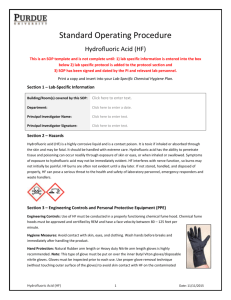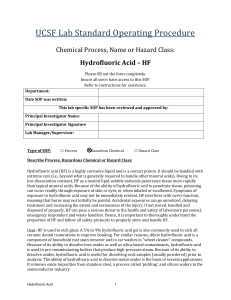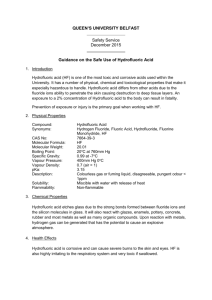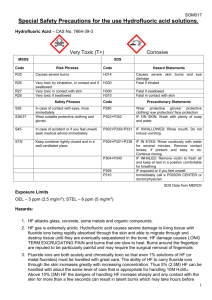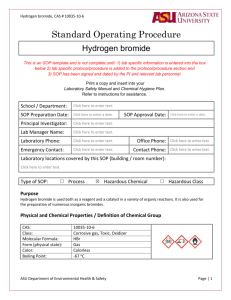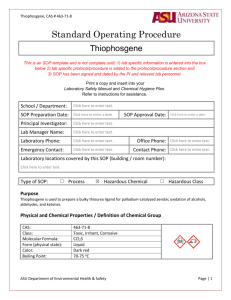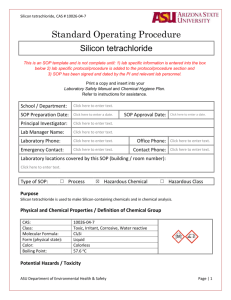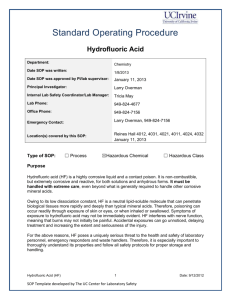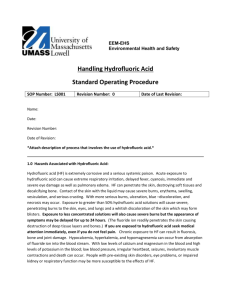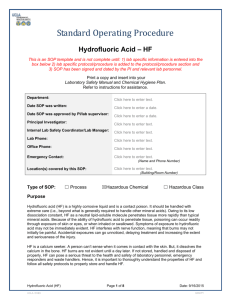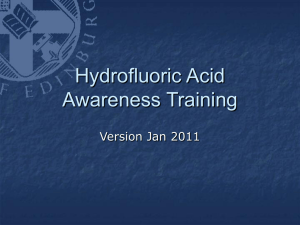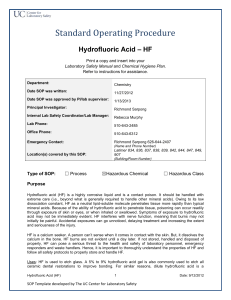Hydrofluoric acid (HF Solutions)
advertisement
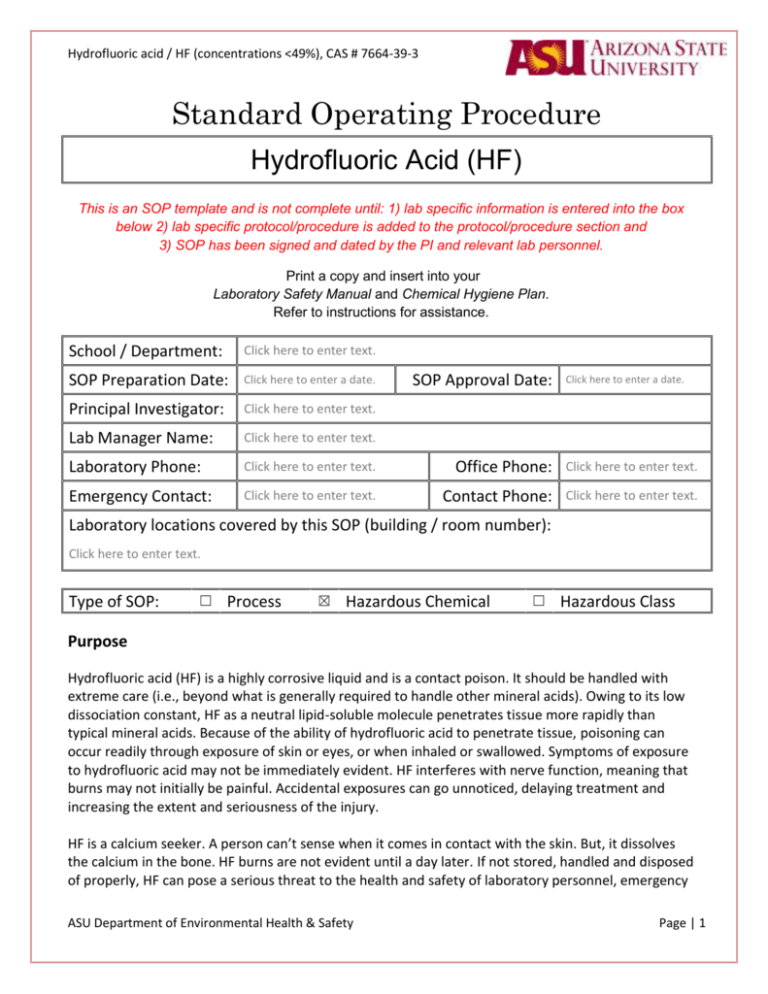
Hydrofluoric acid / HF (concentrations <49%), CAS # 7664-39-3 Standard Operating Procedure Hydrofluoric Acid (HF) This is an SOP template and is not complete until: 1) lab specific information is entered into the box below 2) lab specific protocol/procedure is added to the protocol/procedure section and 3) SOP has been signed and dated by the PI and relevant lab personnel. Print a copy and insert into your Laboratory Safety Manual and Chemical Hygiene Plan. Refer to instructions for assistance. School / Department: Click here to enter text. SOP Preparation Date: Click here to enter a date. Principal Investigator: Click here to enter text. Lab Manager Name: Click here to enter text. Laboratory Phone: Click here to enter text. Office Phone: Click here to enter text. Emergency Contact: Click here to enter text. Contact Phone: Click here to enter text. SOP Approval Date: Click here to enter a date. Laboratory locations covered by this SOP (building / room number): Click here to enter text. Type of SOP: ☐ Process ☒ Hazardous Chemical ☐ Hazardous Class Purpose Hydrofluoric acid (HF) is a highly corrosive liquid and is a contact poison. It should be handled with extreme care (i.e., beyond what is generally required to handle other mineral acids). Owing to its low dissociation constant, HF as a neutral lipid-soluble molecule penetrates tissue more rapidly than typical mineral acids. Because of the ability of hydrofluoric acid to penetrate tissue, poisoning can occur readily through exposure of skin or eyes, or when inhaled or swallowed. Symptoms of exposure to hydrofluoric acid may not be immediately evident. HF interferes with nerve function, meaning that burns may not initially be painful. Accidental exposures can go unnoticed, delaying treatment and increasing the extent and seriousness of the injury. HF is a calcium seeker. A person can’t sense when it comes in contact with the skin. But, it dissolves the calcium in the bone. HF burns are not evident until a day later. If not stored, handled and disposed of properly, HF can pose a serious threat to the health and safety of laboratory personnel, emergency ASU Department of Environmental Health & Safety Page | 1 Hydrofluoric acid / HF (concentrations <49%), CAS # 7664-39-3 responders and waste handlers. Hence, it is important to thoroughly understand the properties of HF and follow all safety protocols to properly store and handle HF. Uses: HF is used to etch glass. A 5% to 9% hydrofluoric acid gel is also commonly used to etch all ceramic dental restorations to improve bonding. For similar reasons, dilute hydrofluoric acid is a component of household rust stain remover and in car washes in "wheel cleaner" compounds. Because of its ability to dissolve iron oxides as well as silica-based contaminants, hydrofluoric acid is used in pre-commissioning boilers that produce high-pressure steam. Because of its ability to dissolve oxides, hydrofluoric acid is useful for dissolving rock samples (usually powdered) prior to analysis. The ability of hydrofluoric acid to dissolve metal oxides is the basis of several applications. It removes oxide impurities from stainless steel, a process called ‘pickling’, and silicon wafers in the semiconductor industry. Physical and Chemical Properties / Definition of Chemical Group CAS: Class: Molecular Formula: Form (physical state): Color: Boiling Point: 7664-39-3 Very toxic & Corrosive HF Liquid Colorless Not applicable Potential Hazards / Toxicity Potential Health Effects HF removes calcium from the body in affected area (targets the bone). Target Organs: Liver, kidney Toxic if inhaled. Material is extremely destructive to the tissue of the mucous Inhalation: membranes and upper respiratory tract. Skin: May be fatal if absorbed through skin. Causes skin burns. Eyes: Causes eye burns. Causes severe eye burns. Ingestion: May be fatal if swallowed. Personal Protective Equipment (PPE) Respiratory Protection Respirators should be used only under any of the following circumstances: As a last line of defense (i.e., after engineering and administrative controls have been exhausted). ASU Department of Environmental Health & Safety Page | 2 Hydrofluoric acid / HF (concentrations <49%), CAS # 7664-39-3 When Permissible Exposure Limit (PEL) has exceeded or when there is a possibility that PEL will be exceeded. Regulations require the use of a respirator. An employer requires the use of a respirator. There is potential for harmful exposure due to an atmospheric contaminant (in the absence of PEL) As PPE in the event of a chemical spill clean-up process Lab personnel intending to use/wear a respirator mask must be trained and fit-tested by EH&S. This is a regulatory requirement. (http://www.asu.edu/uagc/EHS/documents/asu_respriatory_protection_plan.pdf) Hand Protection Natural Rubber arm length or Heavy duty Nitrile arm length gloves is highly recommended. NOTE: This type of gloves must be put on over the inner Butyl Viton gloves/disposable nitrile gloves. Gloves must be inspected prior to each use. Use proper glove removal technique (without touching outer surface of the gloves) to avoid skin contact with HF on the contaminated gloves. Dispose of inner nitrile gloves after use as hazardous waste. *Inner Butyl Viton gloves can be reused carefully (i.e., without touching the outer surface of the gloves). Wash hands thoroughly with warm water and soap. NOTE: Consult with your preferred glove manufacturer to ensure that the gloves you plan on using are compatible with Hydrofluoric acid. Refer to glove selection chart from the links below: http://www.ansellpro.com/download/Ansell_8thEditionChemicalResistanceGuide.pdf OR http://www.allsafetyproducts.biz/page/74172 OR http://www.showabestglove.com/site/default.aspx OR http://www.mapaglove.com/ Eye Protection Tightly fitting safety goggles and face shield. Skin & Body Protection Lab coat and natural rubber apron Full-length pants Close-toe rubber or leather shoes ASU Department of Environmental Health & Safety Page | 3 Hydrofluoric acid / HF (concentrations <49%), CAS # 7664-39-3 NOTE: If HF is used in a cleanroom, the cleanroom gown will substitute for lab coat and full length pants. In addition, all the other PPE listed in this section is applicable. Hygiene Measures Avoid contact with skin, eyes, and clothing. Wash hands before breaks and immediately after handling the product. Engineering Controls Must be used within an annually certified chemical fume hood or an exhausted chemical wet bench. First Aid Procedures If inhaled… Move to fresh air. If the person is not breathing, give artificial respiration. Avoid mouth to mouth contact. Call 911 from a campus phone or (480) 965-3456. Call EH&S at (480) 965-1823. In case of skin contact… Remove all contaminated clothing. Immediately (within seconds) flush affected area for FIVE (5) minutes. Call 911 from a campus phone or (480) 965-3456 from a cell phone. Call EH&S at (480) 965-1823. Wearing compatible gloves, massage calcium gluconate gel into the affected area. Re-apply every 15 minutes until medical help arrives. Note: Hydrofluoric acid exposure is often treated with calcium gluconate, a source of Ca2+ that sequesters the fluoride ions. HF chemical burns can be treated with a water wash and 2.5% calcium gluconate gel, or special rinsing solutions. However, because it is absorbed, medical treatment is necessary; rinsing off is not enough. Intraarterial infusions of calcium chloride have also shown great effectiveness in treating burns. In some cases, amputation may be required. In case of eye contact… Use nearest emergency eyewash immediately. Call 911 from a campus phone or (480) 965-3456 from a cell phone. Call EH&S at (480) 965-1823. If swallowed… DO NOT INDUCE VOMITING. Give large quantities of milk (preferable) or water. Never give anything by mouth to an unconscious person. Call 911 from a campus phone or (480) 965-3456 from a cell phone. Call EH&S at (480) 965-1823. Special Storage & Handling Requirements Storage HF must always be stored in plastic (Nalgene or polypropylene) containers. Ensure the container is tightly closed at all times. DO NOT store HF in glass bottles / containers. ASU Department of Environmental Health & Safety Page | 4 Hydrofluoric acid / HF (concentrations <49%), CAS # 7664-39-3 Store in corrosive / acid storage cabinet within a secondary containment tub made of Nalgene or polypropylene. DO NOT store on the top most shelf of the storage cabinet. NOTE: In general, do not store chemicals at or above eye level. DO NOT store with oxides, organic chemicals, bases or metals. Handling Verify tube of at least 30 grams of 2.5% Calcium gluconate gel is readily available, in a gel-like condition, and the shelf life has not been exceeded. The lab where the material is being handled has an approved / certified emergency eyewash and safety shower. Ensure you are wearing the following minimum PPE: tightly fitting safety goggles and face shield, lab coat & natural rubber apron, full length pants, close-toe rubber or leather shoes, gauntlet style (or arm length) natural rubber gloves over a pair of nitrile gloves. Carefully carry the stock bottle in a rubber maid bottle carrier / Nalgene secondary container to the chemical fume hood and pour out desired amount into a smaller container. Place stock bottle back in corrosive chemical storage cabinet with cap tightly closed. ASU EH&S policy prohibits working alone with hazardous materials, hazardous equipment, or hazardous processes (unless authorized by the Principal Investigator or EH&S). A buddy system is highly recommended when handling HF. Lab emergency contact information must be readily posted. Easy access to a cellular phone or land line is readily available. Spill and Accident Procedure Personal precautions Avoid breathing vapors, mist or gas. Ensure adequate ventilation. Evacuate personnel to safe areas. Do not attempt clean-up without minimum PPE. Environmental precautions Prevent further leakage or spillage – if safe to do so. Do not allow product to enter drains. Methods and materials for containment and clean-up Consider material compatibility prior to clean-up. Verify an HF spill kit is available which contains the following: neutralizing agent (Sodium carbonate is recommended), disposable scoop and a compatible waste collection container or plastic bag. 1. Immediately assess amount spilled, follow posted ASU Emergency Response Guide procedures for hazardous materials incidents. 2. If HF exposure has occurred, a fellow lab worker shall call 9-1-1 and EH&S at (480) 965-1823. 3. Use neutralizing agent (sodium carbonate) to cover the spilled liquid. 4. A liquid binding material (vermiculite, sand, kitty litter) may be used to absorb the liquid. 5. Pick up contaminated material with a disposable scoop into a double-bagged ziplock or other compatible container. ASU Department of Environmental Health & Safety Page | 5 Hydrofluoric acid / HF (concentrations <49%), CAS # 7664-39-3 6. Label and tag as hazardous waste and submit a pick-up request to EH&S using EHS Assistant. Decontamination / Waste Disposal Procedure Label waste Attach a completed ASU Hazardous Waste tag to all waste containers as soon as the first drop of waste is added to the container. Store waste Store hazardous waste in closed containers, in secondary containment and in a designated storage location. Double-bag dry waste using sealable transparent bags. Waste must be under the control of the person generating and disposing of it. Dispose of waste Dispose of regularly generated chemical waste within 90 days. Use EHS Assistant online hazardous waste pick-up request system. Contact ASU EH&S at (480) 965-1823 with questions. Protocol / Procedure Laboratory-specific procedures Add your lab’s specific procedures in this section. Click here to enter text. IMPORTANT NOTE: Any deviation from this SOP requires advance PI approval. Documentation of Training Prior to conducting any work with Hydrofluoric acid (HF), Principal Investigator or designee must provide to his/her laboratory personnel specific to the hazards involved in working with this substance, work area decontamination, and emergency procedures. The Principal Investigator must provide his/her laboratory personnel with a copy of this SOP and a copy of the MSDS provided by the manufacturer. The Principal Investigator must ensure that his/her laboratory personnel have attended appropriate/required laboratory safety training or refresher training within the last one year. I have read and understand the content of this SOP. Employee Name ASU Affiliate No. Click here to enter text. Click here to enter text. Click here to enter text. Click here to enter text. Click here to enter text. Click here to enter text. Click here to enter text. Click here to enter text. ASU Department of Environmental Health & Safety Signature Date Click here to enter a date. Click here to enter a date. Click here to enter a date. Click here to enter a date. Page | 6
